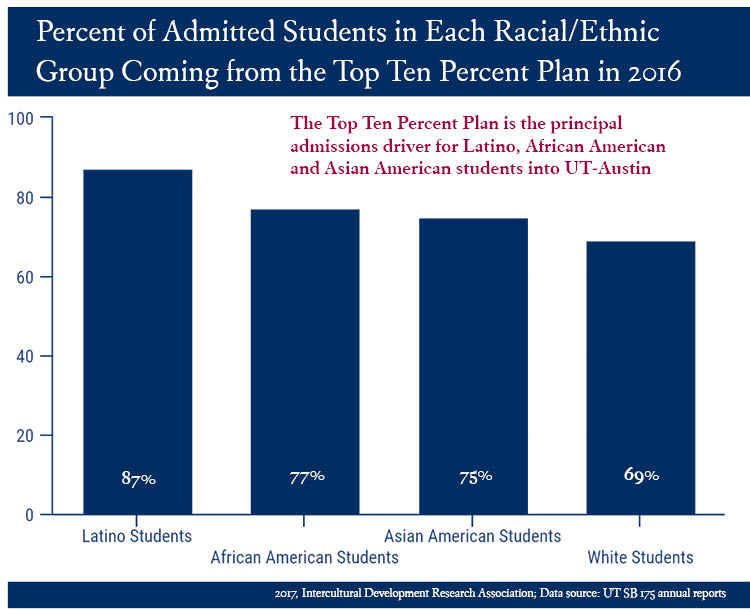• by David Hinojosa, J.D. • IDRA Newsletter • February 2017 •


Nevertheless, some policymakers see this growing diversity as “problematic” and are calling for further reforms. While the Top Ten Percent Plan is not a stand-alone solution to achieving equal access to the state’s universities, the facts show that the plan has been an effective race-neutral measure at increasing racial, geographic and socioeconomic diversity.
Rather than further scaling back on the Top Ten Percent Plan, state policymakers should instead explore how other equitable policies can complement it and support increased enrollment and completion at our public institutions (Hinojosa, 2016).
Background on the Top Ten Percent Plan
In 1995, Texas was faced with a real quandary of higher education access following the Fifth Circuit Court of Appeals’ decision in Hopwood v. Texas. The court struck down the UT law schools’ use of a separate committee to review applications from minority students as unconstitutional (Orentlicher, 1998).
With declining minority student enrollment at UT-Austin and Texas A&M University, the Texas Legislature went to work on a race-neutral admissions plan and passed the Top Ten Percent Plan, House Bill 588, in 1997. Supported by urban Democrats and rural Republicans, this bill required Texas’ four-year public universities to admit high school students graduating in the top 10 percent of their class (Holley & Spencer, 1999). Starting with its 2011 class, UT-Austin alone was allowed to limit those students to 75 percent of the freshmen class.
Increased Access for Underrepresented Groups
The Top Ten Percent Plan has opened the doors of the flagship universities to low-income, rural and minority communities – all groups who were typically denied access to the flagships. Facts derived from IDRA’s analyses of the Top Ten Percent Plan at UT-Austin for example include the following findings.
The Top Ten Percent Plan has helped increase the number of feeder high schools into UT-Austin, from 622 in 1996, to 792 in 2000, to 992 in 2016 (Montejano, 2001).
Rural schools continue to benefit from the Top Ten Percent Plan, with UT-Austin admitting a total of 109 students from 87 rural schools in 2016, up from 85 students and 65 rural schools in 2010. The plan accounted for 83 percent of admitted rural students in 2016.
The Top Ten Percent Plan is the principal admissions driver for African American, Latino and Asian American students into UT-Austin, with 87 percent of admitted Latino students coming from the Top Ten Percent Plan along with 77 percent of African American students, 75 percent of Asian American students but only 69 percent of White students in 2016.
The Top Ten Percent Plan yields greater diversity based on income and degree attainment, with 28 percent of UT’s Top Ten Percent Plan enrolled students coming from families earning less than $60,000 annually compared to only 11 percent for non-Top Ten Percent Plan students. And 16 percent of Top Ten Percent Plan parents had a high school diploma or less comparedto 4 percent of non-Top Ten Percent Plan parents in 2016.


Policy Recommendations for Ensuring Access and Opportunity
So where do we go from here? Research shows the overwhelming educational, social and economic benefits that flow from a more diverse university student body, such as developing critical thinking and problem solving skills, helping to reduce racial isolation, dispelling racial stereotypes and promoting cross-racial understanding, and building leadership that helps prepare students for life after college (Fisher v. UT Austin Brief, 2015).
As a group of Fortune 100 companies explained, student racial diversity is a “business and economic imperative” in the growing, diverse global market (Fisher v. UT Austin, 2015). So how can the state reap these benefits and expand diversity and opportunity?
IDRA’s following recommendations represent a blueprint for helping to ensure all qualified students gain access to our public universities.
1. Maintain the current blended admissions plan of the holistic admissions plan coupled with the Top Ten Percent Plan capped at 75 percent of admissions for UT-Austin. However, the holistic plan must be revised to ensure qualified African American and Latino students are not overlooked.
2. Re-regulate tuition at the higher-cost public universities but ensure universities have adequate resources to help make up the difference. Texas lags behind competitor states in the percentage of the state’s gross domestic product spent on public education, including post-secondary education (Harris & Tienda, 2012). If the state were to invest more appropriately, it would begin to reign in high tuition rates.
3. Provide greater financial aid to students in need. In past sessions, the state has cut already-reduced levels of financial aid based on need. The state must ensure that students not only are admitted but also can afford to enroll and complete college without excessive debt.
4. Texas must take major steps toward investing in at least five additional major universities. With 80,000 new students entering Texas PK-12 public schools each year, the state must come to terms with expanding Tier I universities.
5. UT-Austin and other public universities must engage in meaningful outreach to underserved communities. As the training ground for future leaders, universities like UT-Austin must collaborate more meaningfully with underserved high schools and students, similar to what has been done with job training, community colleges and public schools.
6. Texas must re-align its PK-12 curriculum and graduation requirements with college expectations. Unlike its predecessor, the state’s new default PK-12 curriculum adopted under HB 5 in 2013, the “Foundation plus endorsement” program, does not meet many of the college entrance requirements and, worse, could lead to the channeling of students by race and poverty into less rigorous tracks (IDRA, 2013).
7. Texas must adequately and equitably support its PK-12 public education system to help prepare students for college and a career. Regardless of the Supreme Court of Texas’ decision on the legal merits of the most recent school finance case, the facts have not changed and the needs of the state’s growing, diverse student population have not been met (Texas Taxpayer v. Williams, 2016). Texas must reverse course and support college-readiness in all public schools.
Texas can ill-afford to turn the clock back now as the results would likely be devastating, particularly for minority and rural communities (IDRA, 2009a). As IDRA stated in its testimony before the Texas Legislature when the state previously considered reductions to the Top Ten Percent Plan, “It is ironic that at a time when expanding global competition requires better educated citizens, Texas is discussing ways to limit access of its top students to its top institutions of higher learning” (IDRA, 2009b).
Texas instead should choose to be a leader as an investor in public education, including higher education, which is not only an investment in that child and the schooling, but an investment in the state’s social, political and economic future.
See IDRA’s amicus brief for the Fisher v. UT Austin case
.
Resources
Abigail Noel Fisher v. University of Texas at Austin, et al. (September 2015). Brief of Fortune-100 and other leading American businesses as amici curiae in support of respondents (No. 11-345, affirmative action, consideration of race in University of Texas admissions).
Brief for IDRA as Amici Curiae Supporting Respondents, Fisher v. UT Austin (2015) (no. 14-981).
Harris, A., & M. Tienda. (April 2012). “Hispanics in Higher Education and the Texas Top Ten Percent Law,” Race and Social Problems, 4(1): 57-67.
Hinojosa, D. (Spring 2016). “Of Course the Texas Top Ten Percent is Constitutional…And It’s Pretty Good Policy Too,” Texas Hispanic Journal of Law & Policy.
Holley, D., & D. Spencer. (1999). “The Texas Ten Percent Plan,” Harvard Civil Rights-Civil Liberties Law Review (245).
Hopwood v. State of Texas. (2003). 78 F.3d 932 (5th Circuit 1996) abrogated by Grutter v. Bollinger, 539 U.S. 306, 123 S. Ct. 2325, 156 L. Ed. 2d 304 (2003).
IDRA. (2013). Tracking, Endorsements and Differentiated Diplomas – When ‘Different’ Really is Less (San Antonio, Texas: Intercultural Development Research Association).
IDRA. (March 11, 2009a). Research Relating to Measures that Would Limit the Texas Top Ten Percent Plan (San Antonio, Texas: Intercultural Development Research Association).
IDRA. (March 11, 2009b). Testimony on HB 52 Relating to the Texas Top Ten Percent Plan (San Antonio, Texas: Intercultural Development Research Association).
Montejano, D. (2001). “Access to the University of Texas at Austin and the Ten Percent Plan: A Three Year Assessment.”
Orentlicher, D. (1998). “Affirmative Action and Texas’ Ten Percent Solution: Improving Diversity and Quality,” Notre Dame Law Review (181, 183-85).
Texas Taxpayer & Student Fairness Coalition, et al., v. Williams, No. D-1-GN-11-003130, 2014 WL 4254969 (Tex. App.-Travis Aug. 2014) reviewed in part and affirmed in part on appeal, Morath v. Texas Taxpayer & Student Fairness Coalition, No. 14-0776 (Tex. 2016) (“Texas Taxpayer”).
—————————————-
David Hinojosa, J.D., is the IDRA National Director of Policy and Director of the IDRA EAC-South. Comments and questions may be directed to him via email at david.hinojosa@idra.org. Portions of this newsletter have been excerpted from his article “Of Course the Texas Top Ten Percent is Constitutional…And It’s Pretty Good Policy Too,” Texas Hispanic Journal of Law & Policy (Spring 2016).


